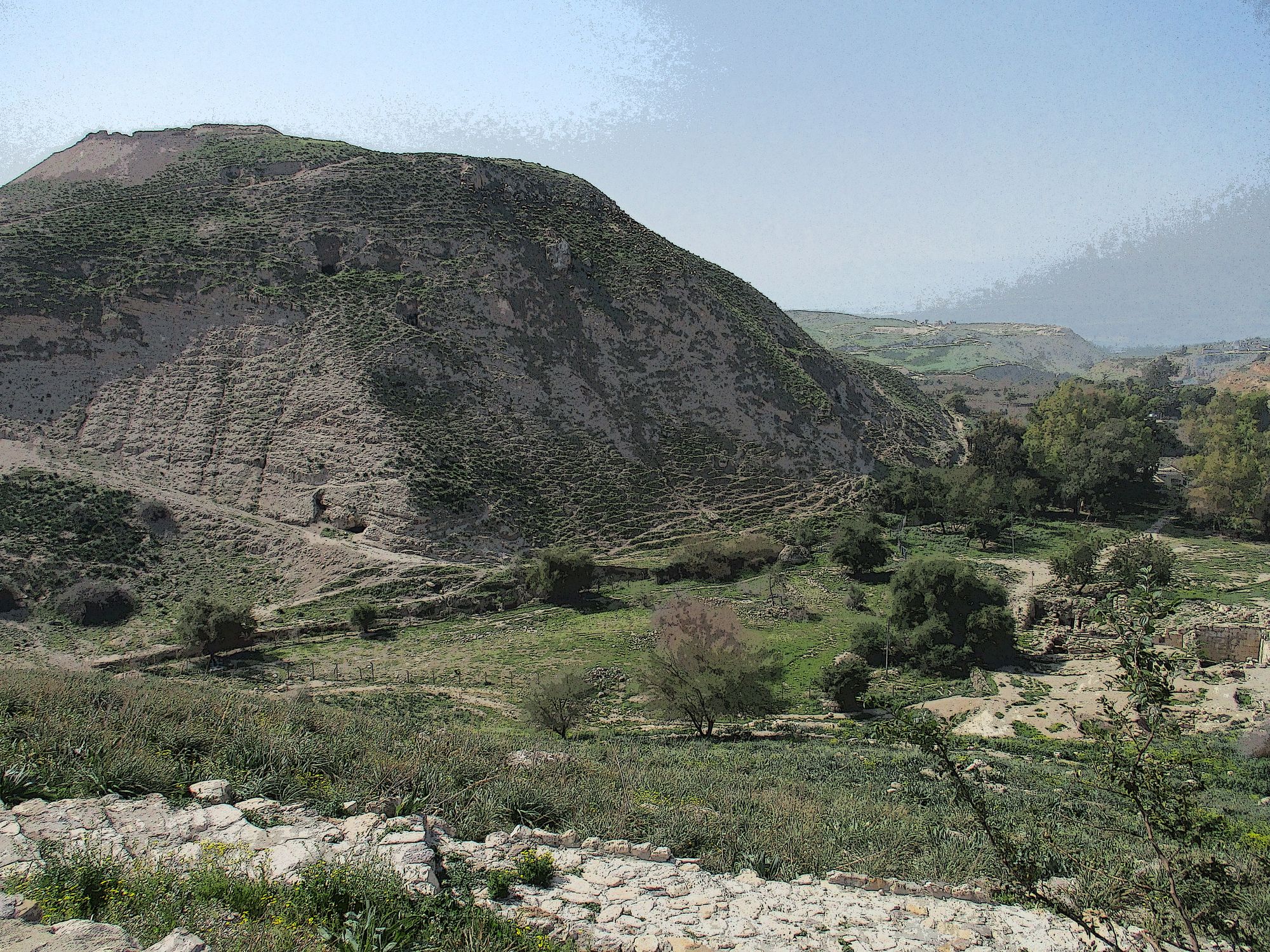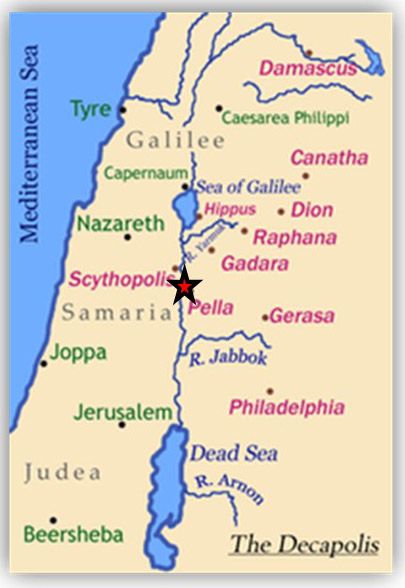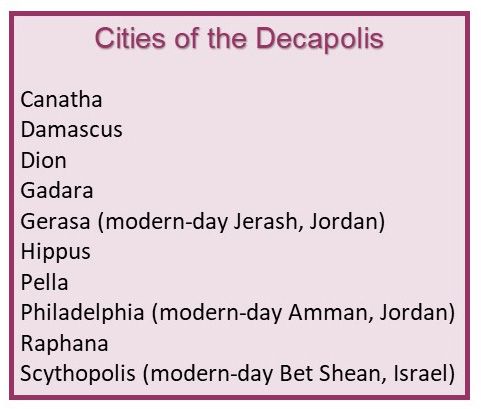Did First-century Christians Flee to Pella? - Part 1

Controversy surrounds the story that Christians of the first-century church in Jerusalem fled to a small town called Pella in response to Jesus' statement of what to do when they saw Roman armies surround their city.
"But when you see Jerusalem surrounded by armies, then know that desolation has come near.
Then let those who are in Judea flee to the mountains, and let those who are inside the city depart, and let not those who are out in the country enter it, for these are days of vengeance, to fulfill all that is written." Luke 21:20-22 (ESV)
The fourth-century Church historian, Eusebius, wrote, "But the people of the church in Jerusalem had been commanded by a revelation (an "oracle" he says elsewhere), vouchsafed to approved men there before the war, to leave the city and to dwell in a certain town of Perea called Pella." [1] Later, Epiphanius also records this flight of the Christians to Pella.
The destruction of the city, Eusebius says, came only after the Jerusalem Christians made their escape. A late first- or early second-century sarcophagus found beneath the floor of a church in the western part of Pella may be a relic of the Christians' stay in the city. [2]
Years later, Epiphanius wrote essentially the same thing. He and Eusebius obtained their information from Ariston of Pella, and for millennia, theirs was the prevailing story of what happened to the mother church at Jerusalem before Rome destroyed the city.
The idea of Jerusalem's Christians fleeing to Pella is controversial to this day.
In 1951, however, S. G. F. Brandon wrote a book called, The Fall of Jerusalem and the Christian Church, in which he insisted those in the church perished in the war because they were aligned with the Zealots. His main premise was that the church of Jerusalem "identified itself too closely with the nation from which it had originally emerged," and it subsequently shared in Israel's virtual annihilation."[3] He argued not only did Christianity cease to exist in its original Jewish form, but it was subsequently "virtually reborn."[4] In other words, the Church could not move out into the Gentile world until it became unfettered by its nationalistic limits of Judaism. His treatise gained some support, and the idea of Jerusalem's Christians fleeing to Pella is controversial to this day.
It can be argued both Eusebius and Mr. Brandon embrace anti-Semitism.
The purpose of this blogpost is not to argue for or against whether Christians fled Jerusalem before its destruction. There is no surviving documentation from the Jerusalem Church after this time. There's no proof of what either side says is true. Only circumstantial evidence and opinion.
The point of this article is God will make a place of escape and refuge before and during the coming Tribulation.
There are archeological finds showing Christians did inhabit Pella later. Al and I saw ruins of three churches during our recent visit there.
Centuries later, Christianity gradually influenced and took over the Roman and Byzantine Decapolis region, Pella included. Not all cities were receptive to the new religion, paganism persisting long into the Byzantine era, but eventually, the region became almost entirely Christian, and most of the cities served as seats of bishops.[5]
The point of this article is God will make a place of escape and refuge before and during the coming Tribulation. For clarity's sake, I am quoting Daniel's prophecy below in the Contemporary English Version. I encourage you to read it in other versions as well.
"This king (Antichrist) will reject the gods his ancestors worshiped ... and worship only the so-called god of fortresses, who was unknown to his ancestors.
"With the help of this foreign god, he will capture the strongest fortresses. Everyone who worships this god will be put in a position of power and rewarded with wealth and land.
"At the time of the end, the king of the south will attack the kingdom of the north. But its king (Antichrist) will rush out like a storm with war chariots, cavalry, and many ships. Indeed, his forces will flood one country after another, and when they reach the holy land, tens of thousands will be killed. But the countries of Edom and Moab and the ruler of Ammon will escape.
"The king of the north (Antichrist) will invade many countries, including Egypt, and he will take its rich treasures of gold and silver. He will also conquer Libya and Ethiopia." Daniel 11:37-43 (CEV)
Edom, Moab, and Ammon comprise today's Kingdom of Jordan.

I will describe the setting of what was going on at that time in history which led to the premise Pella was a place of safety. It includes a region called the Decapolis and a group of people known as the Zealots.
THE DECAPOLIS
The Bible mentions Decapolis three times in connection with something Jesus (Yeshua in Hebrew) was doing. Matthew 3:24-25 talks about the massive crowds following the Lord, some from the Decapolis. Mark 5:20 recounts the story of the demoniac man whose demons Yeshua cast out and were allowed to inhabit 2,000 swine who ran into the sea. He wanted to follow the One Who set him free, but Yeshua told him it would be better if he spread the news to those he lived among. "And he departed, and began to publish in Decapolis how great things Jesus had done for him." Then, Mark 7:31 narrates one of the many times Yeshua crisscrossed the land teaching, healing, and entering into the Decapolis.
The term means "ten cities," even though there may have been as many as fourteen.


Even though I had read the name of Decapolis many times in Bible study, I didn't know when it came into being, where it was, nor anything about it. I do remember wondering why there were 2,000 pigs in Israel. The answer is the miracle did not take place in Israel, but in a region of Hellenistic inhabitants.
The Decapolis formed after the Roman conquest of Israel in 63 B.C. The non-Jews who lived there welcomed Roman General Pompey's releasing them from Jewish Hasmonean rule. In return, he granted them autonomy and Roman protection.[6] All of the cities that were part of this loose-knit league were east of the Jordan River in today's Hashemite Kingdom of Jordan. Only one, Scythopolis, was within Israel's border, barely across the western bank of the Jordan River. "The cities participated in the Decapolis as a means of mutual protection and security against their Semitic neighbours. The league was subject to the Roman governor of Syria, though his authority was somewhat tenuous in eastern Palestine. The cities of the Decapolis created a rich Hellenistic culture."[7] They were Greek from their founding, modeling themselves on the Greek polis.[8] That is why the ancient ruins in Jordan today are peppered with classic Roman buildings and laid out in "a Roman-style grid of streets based around a central cardo."[9]
Pella got its name from Alexander the Great's birthplace in Macedonia. Even today, one of the regional areas of Greece (similar to an American state) is named Pella.
From the start, conflict was inevitable between the Greek colonists and the indigenous Jews and Arameans. The Jewish practice of circumcision shocked the Greeks, who regarded it as a cruel and barbaric genital mutilation."[10] The Hellenistic culture was seductive and often successful in assimilating surrounding cultures. Religious Jews did not like this. The ten-city area was a center to diffuse its values in the surrounding countries. There was bound to be a struggle between values.
THE ZEALOTS
There were four philosophical groups in Israel in the first century A.D.—Pharisees, Sadducees, Essenes, and Zealots. It is the fourth group I'm concerned with in this article. Josephus was the first to name these militant Jews in the War of 66-70. They were ultra-religious.
Judas the Galilean founded the movement in 6 A.D., and those who were zealous for the Torah gathered around him. It wasn't that it was illegal to worship Yehovah. Rome allowed it. But these people were basically fanatics, waging war on all who opposed them, even fellow Jews. But they certainly exhibited bravery, for they endured sieges and torture rather than call anyone "lord," other than God.[11] They did not want to "go along to get along." They wanted the Romans out of their country. They wanted freedom.
In his book, S. G. F. Brandon said the Christians were part of the Zealots, and that's why they were slain. But I, and many others who disagree, don't see the Zealot way of life as compatible with Yeshua's teaching. Turn the other cheek, give your coat to anyone who asks for it, love your enemy—these teachings don't sound like Zealot rhetoric.
The great sage Gamaliel refers to the death of Judas the Galilean in Acts 5:37 when he is instructing the Jewish religious leaders to cease persecuting the new followers of Yeshua. He reminded them of others who claimed to be Messiah and what happened to them:
"For before these days rose up Theudas, boasting himself to be somebody; to whom a number of men, about four hundred, joined themselves; who was slain; and all, as many as obeyed him, were scattered and brought to nought.
"After this man, rose up Judas of Galilee in the days of the taxing and drew away much people after him: he also perished; and all, even as many as obeyed him, were dispersed."
The words, "days of the taxing," refer to when Judas revolted against Rome over the census that was taken by Quirinius, the same census that sent Joseph and Mary to Bethlehem.[12]
There are many ideas of who Yeshua's disciple, Simon the Zealot, was. While it is not clear, it is possible he was Messiah's cousin. Barabbas was clearly a Zealot, according to the Bible and Josephus.[13]
When Titus was on his way to destroy Jerusalem, there were three groups of rebel Zealots in the city, not necessarily friends, but having the same end-goal,[14] and they suffered the same fate.
Between Rome and the Zealots, the stage was set for the destruction of Israel. The followers of Yeshua were no doubt watching for the sign He gave them of when to leave Jerusalem.
There are two other instances of Yeshua's command to leave Judaea in the future time of Tribulation. What Matthew and Mark recorded is worded a little differently from the phrase, "when you see Jerusalem surrounded by armies" in Luke 21 as I mentioned at the beginning of this article. They say:
"But when ye shall see the abomination of desolation, spoken of by Daniel the prophet, standing where it ought not (let him that readeth understand), then let them that be in Judaea flee to the mountains:" Mark 13:14 (KJV)
"When ye therefore shall see the abomination of desolation, spoken of by Daniel the prophet, stand in the holy place (whoso readeth, let him understand), then let them which be in Judaea flee into the mountains." Matthew 24:15-16 (KJV)
The abomination that causes desolation is the act of Antichrist standing in the holy place of a yet-to-be-rebuilt temple in Jerusalem, declaring himself to be God. It is the only time marker we have so we can know where we are in Daniel's seventieth-week prophecy (the Tribulation). It will be the midpoint. It will also be the alarm for those in Judaea to run for the mountains ... of Jordan.

This is the background and foundation of the story of first-generation Christians fleeing to a place of safety. Jordan has historically been a place of refuge. See our previous three posts on the subject. Part 1, Part 2, and Part 3.
Next week, Al's blog will deal with what this means to those who will be alive at the time of the Great Tribulation, looking for a place of refuge.
Click here for a short trailer of our recent trip to Pella. Flight Crew members, I will send you a link for the long version.

FOOTNOTES
[1] Eusebius, Church History, Book III, chapter 5, verse 3.
[2] Smith, R. H. Pella. The New Encyclopedia of Archeaeological Excavations in the Holy Land, Ephraim Stern ed. [New York: Simon and Shuster. 19931. vol 3. 1 175]
[3] Brandon, S. G. F., The Fall of Jerusalem and the Christian Church (1951: 2 ed: London: SPCK 1957), page 184.
[4] Scott, Jr., J. Julius "Did Jerusalem Christians Flee to Pella?" Page 2, November 13, 1998. Paper read at Wheaton College Archaeology Conference, Wheaton, IL
[5] https://en.wikipedia.org/wiki/Decapolis. Accessed 03/30/2023
[6] Ibid., Wikipedia/Decapolis
[7] https://www.britannica.com/place/Decapolis-ancient-cities-Palestine. Accessed 03/31/2023
[8] Ibid., Wikipedia/Decapolis
[9] Arthur Segal (2001). "The Kalybe Structures": Temples for the Imperial Cult in Hauran and Trachon: An Historical-architectural Analysis." Assaph: Studies in Art History. Tel Aviv University. 6:91-118.
[10] Hodges, Frederick M. (2001) "The Ideal Prepuce in Ancient Greece and Rome: Male Genital Aesthetics and Their Relation to Lipodermos, Circumcision, Foreskin Restoration, and the Kynodesme." (PDF) Bulletin of the History of Medicine. Johns Hopkins University Press. 75 (Fall 2001): 375-405. dok:10.1353/bhm.2001.0119. PMID 11568485 S2CID 29580193. Retrieved 13 February 2020.
[11] Gowan, Donald E. Bridge, Between the Testaments (Pittsburgh: The Pickwick Press, 1980), p. 201
[12] Ross, Dr. Allen, "The Religious World of Jesus, Part 6, the Zealots," April 17, 2006. https://bible.org/seriespage/6-zealots. Accessed 03/30/23
[13] Ibid., Ross, Dr. Allen
[14] Ibid., Ross, Dr. Allen
